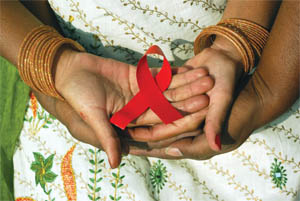HOME
PAST DIGITAL ISSUES
HIV/AIDS HOTLINES
HIV 101
POSITIVE PROFILES
ASO SPOTLIGHT
RECENT ARTICLES
HOW TO PAY FOR HIV TREATMENT AND MEDICATIONS
ADAP CRITERIA AND FORMULARIES
ASO LISTINGS
REVIEW OF HIV MEDICATIONS
2018 HIV/AIDS FUNDRAISING ACTIVITIES & EVENTS
ABOUT HIV POSITIVE! MAGAZINE
LINKS
SUBSCRIBE
CONTACT US
ADVERTISER INFORMATION
Where Do We Stand Right Now?

The world just finished marking World AIDS Day on December 1, and it’s time for our annual review of the “State of AIDS” worldwide.
So where do we stand? We’ve come a long, long way. And this year, certainly, World AIDS Day is not only worth “marking” – it’s worthy of celebration.
Let’s start with a quick look back. The first mention of AIDS came in a health report issued on June 5, 1981. At the time, the disease had not yet even been named. It was spreading like wildfire, and it was deadly. There was no effective treatment, and people – especially gay men - were dying in dedicated AIDS wards in hospitals and hospices all across the country.
A huge turning point occurred in late 1995 and early 1996, when scientists discovered that a combination of three or more AIDS medications, taken in combination, could stop HIV in its tracks. For the first time, AIDS patients were actually able to go home from the hospital and resume a normal life. Since then, HIV medications have gotten better and better, and now HIV infection is considered a chronic manageable disease, rather than a death sentence. A study published in The Lancet in 2008 suggests that a 20-year-old HIV-positive person starting HIV treatment today can expect to live, on average, to the ripe old age of 69. It’s a far cry from the first 15 years of the pandemic, when all you could do for someone dying of AIDS was hold their hand. But – until very recently – the benefits of HIV therapy were largely available only to people living in the developed world. Now, at last, HIV therapy is starting to reach those in the developing world as well, and the results are very positive!
According to UNAIDS – the United Nations agency charged with monitoring the HIV pandemic – new HIV infections and AIDS-related deaths have both fallen by 20%, worldwide, in the past five years. So, at last, a contagion that once seemed destined to rage forever out of control has been checked. It is in retreat!
According to UNAIDS, the total number of people living with HIV/AIDS has risen slightly, to an estimated 33.3 million at the end of 2009, compared with 32.8 at the end of 2008. But that is good news, because it shows that more people are receiving treatment and living longer.
In 2009, UNAIDS reported:
- There were 2.6 million new infections worldwide, down from 3.1 million in 2004- There were 1.8 million AIDS-related deaths, down from 2.1 million in 2004
- There were 370,000 children born with HIV, down about 24% from five years earlier
- There were 5.2 million people on treatment, up spectacularly from a paltry 700,000 in 2004
Of course, there is more work to be done. Ten million people still need treatment, and aren’t getting it. And, partly because of the global recession, donor governments gave $7.6 billion to fight against AIDS in 2009, down from $7.7 billion in 2008. Still, there has been remarkable progress.
On other fronts:The Catholic Church recently indicated it will reverse its opposition to using condoms for HIV prevention – a positive step, but one that is shamefully late in coming.
Though progress on an AIDS vaccine continues to be excruciatingly slow, another means of prevention – PrEP, or Pre-Exposure Prophylaxis - offers a powerful new tool for prevention. (Please see the article in this issue titled, “A Pill a Day Keeps the Doctor Away.”)
A study conducted in South Africa of a vaginal gel made of 1% Viread (tenofovir) produced the first positive results yet for a woman-controlled means of protection against HIV infection. The study enrolled women aged 18 to 40 at two clinical sites in South Africa, one urban and the other rural. Participants were provided with pre-filled vaginal applicators. They were told to insert the gel 12 hours before sex and as soon as possible within 12 hours after sex. A control group was given a placebo gel in an identical applicator, with the same instructions.
Thirty-eight of the 445 women assigned to the active gel became infected with HIV, versus 60 of the 444 in the placebo group. So the incidence of infection for women receiving tenofovir gel was 39% lower than women receiving a placebo. Interestingly, fewer women getting the active gel were infected with herpes simplex as well. (Tenofovir is active against herpes.)
This study was big news, despite the relatively modest success rate, because earlier trials of other compounds – notably nonoxynol 9 – actually appeared to increase the participants’ susceptibility to HIV. More research will be done along this line to see if they can’t get even better results next time.
Regrettably, there is still no actual cure for HIV – and none in sight.
And so we all fight on. With the worldwide rate of HIV infections and AIDS deaths both down substantially, the legions of caring people worldwide who have thrown themselves into the fight against this disease can say to themselves, at last: we’re winning.
Copyright 2018, Positive Health Publications, Inc.
This magazine is intended to enhance your relationship with your doctor - not replace it! Medical treatments and products should always be discussed with a licensed physician who has experience treating HIV and AIDS!